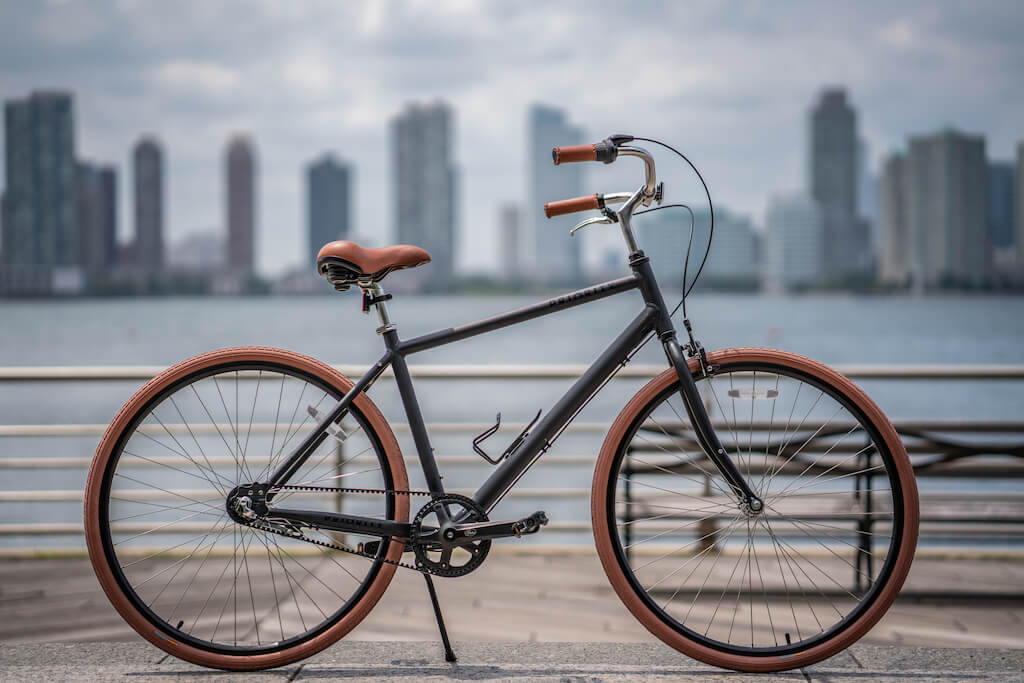Autumn Gear Guide
Find inspiration in our Gear Guide that will keep you out on your bike through wind or rain.
Download NowTop 5 belt-drive commuter bikes Although more and more people are picking up on the advantages of belt-drive bikes, it’s still a niche style. Now, with more people choosing bicycles in general, and more getting ready to bike to work this fall, we decided to take a look at the possibilities of this style and […]

Although more and more people are picking up on the advantages of belt-drive bikes, it’s still a niche style. Now, with more people choosing bicycles in general, and more getting ready to bike to work this fall, we decided to take a look at the possibilities of this style and how to compare belt drives with the tried-and-true chain and derailleur.
First, the basics. Belt-drives replace the traditional steel chains on bicycles with a polyurethane or carbon fiber belt. The belt drive has been around for many years in both bicycles as well as motorcycles — Harley Davidson, for example, has been using belt drives since 1992. Belt drives only work with internal gear hubs and require a split in the frame in the rear triangle.
Commuter and city bicycles have embraced the belt, perhaps not en masse, but more than any other style of bicycle. And it could be because the advantages that belt drives convey are of particular interest to urban cyclists.
New York City-based Priority Bicycles hopped on the belt-drive groove introducing an affordable, belt-drive city bicycle to the market following a successful Kickstarter campaign back in 2014. And it hasn’t looked back.
“The three main advantages of belt drive bicycles are cleanliness, durability, and ride experience,” says Connor Swegle, Priority Bicycles co-founder and CMO. “The Gates Carbon Drive—featured on all our bicycles—is rust and grease-free so you don’t have to worry about getting grease on your pants, leg or hands during daily rides, and it’s certainly a lot cleaner during bicycle upkeep.”
In the city, your bicycle can get covered in road grit, oil, or worse, especially when biking to work. To take bicycle commuting seriously is to weather, ahem, all riding conditions. And that’s not always easy on bicycles, so having a low-maintenance option that doesn’t require too much pampering is a real boon.
“With a belt-drive, you just rinse with a hose and go,” Swegle says. “For durability, belt drives utilize internally geared hubs. Between a Gates Carbon Drive that last two to three times longer than a traditional chain, and internally geared hubs whose maintenance intervals are far less frequent than traditional cassettes and derailleurs, you get an on-demand ride experience that’s unhampered by regular wear and tear. Lastly, the belt drive and ancillary components create an ultra-smooth, responsive ride that’s incomparable to a chained bicycle.”

As mentioned, Gates Corp. is the company responsible for the Carbon Drive system, a high-performance chain-replacing technology that consists of two metal sprockets and a high-strength, carbon fiber embedded belt, which is used by many bicycle brands in addition to Priority.
The Gates Carbon Drive, or “belt drive” as it has come to be known, is a completely grease-free, low-maintenance alternative to a standard roller chain. It’s capable of handling the same or greater maximum load standards as a chain drive, so it can be ridden hard. And since there’s no meeting of metal on metal, a bicycle with a belt drive is virtually silent.
According to Gates, 400 bicycle models are using its belt-drive system, across many styles.
Some of the disadvantages of a belt-drive system include compatibility issues, belts are less efficient at lower power inputs meaning it does require a bit more energy from cyclists when compared to chains, belt drives cost more and because they are still niche spare parts are sometimes hard to find.
Perhaps most important for commuters, if something serious happens, such as an accident that results in a rip or broken belt, replacing it on the fly might not be an option. But, overall, despite a higher upfront cost for a belt drive versus a chain, there are lower maintenance intervals helping balance things out. Belts also last two to three times longer than traditional chains without any need for lube or adjustments.
“Belt drive bicycles tend to be a bit more expensive than derailleurs because you can put a low-grade derailleur on a bicycle. While you may save a few dollars, your maintenance interval skyrockets,” Swegle says. “We’ve all had the experience where you have 18 or 21 speeds but can only use five or six because you get clanking or skipping in other gears. With a belt-drive, you get an ultra-smooth ride and comparable gear range, without the need for routine tune-ups. You won’t be facing the situation where you put your bike in the garage for the winter and need to get it tuned up just to get a working range of gears or one that you can comfortably experience without clanking or grinding.”
So, overall the cost-benefit is there for belt-drive bicycles. And that has given commuters the confidence to embrace the style because if it’s easier to maintain and can plow through winter without issue, that’s huge. Doing so with a comparable cost overall is likely to mean more and more checking-out belt drives.
“Between the belt drive and internally geared hub, you have bicycles that are just easier to ride and maintain,” explains Swegle. “That’s why we have bicycles for kids, commuters, cruisers, and even adventurers—all with the Gates Carbon Drive because it just makes for a better, more dependable experience.”
Find inspiration in our Gear Guide that will keep you out on your bike through wind or rain.
Download Now
Leave a comment